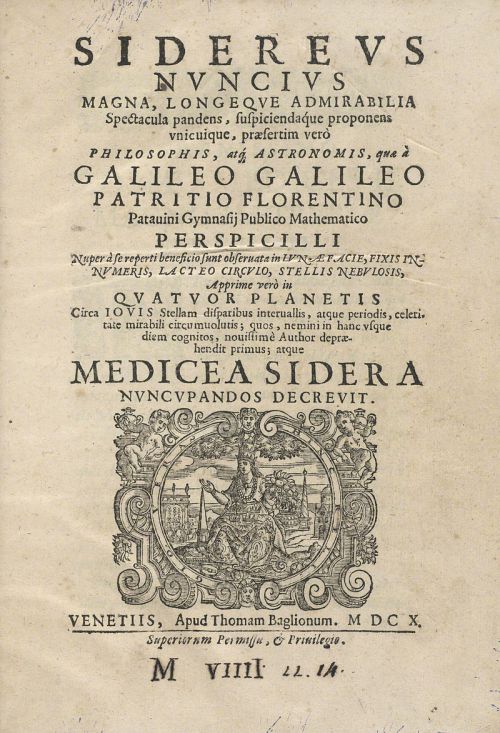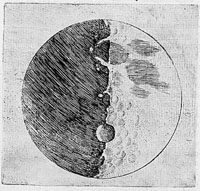
(Credit: Wikimedia Commons)
Scientific discoveries often progress step by step with technological improvements. The invention of the telescope in 1608 by Dutch spectacle makers provided the tool need to transform astronomy. Word spread quickly of this new invention, and by April 1609 one could be purchased in eyeglass shops in Paris. Later that same year it spread into Italy, where word of it came to the Italian polymath Galileo Galilei. Galileo did not actually see a telescope, but based on its description he went ahead with the task of creating his own. He vastly improved the instrument allowing for some of the most revolutionary and groundbreaking discoveries in the history of science.
It didn’t take very long for Galileo to make his discoveries known. Published by Galileo in 1610, Sidereus Nuncius (or Starry Messenger) revealed to the world his observations as he viewed the night sky through his improved telescope. These new observations and discoveries changed how we viewed the composition of the universe and our place among the cosmos. Unfortunately for Galileo at the time, they came in direct contradiction with Aristotelian cosmology, Ptolemaic astronomy, and the most significantly the theological teachings of the Roman Catholic Church. The evidence presented in the book sided more with the Copernican System of the universe, placing the Sun at the center of the Solar System.
The Starry Messenger and its Findings
The Starry Messenger is a short book of about 60 pages written in Latin by Galileo, published on March 13, 1610. It is historically important not only for its shocking content, but it was the world’s first scientific publication derived from telescope observations. The book consists of an introduction, some observations made by Galileo through his telescope, and his conclusions based on those observations. Galileo also included dozens of supplementary drawings of his observations. Despite its brevity, the impact of the work was profound.
Let’s take a look at some of the profound observations and conclusions of the Starry Messenger:
- Craters and Mountains on the Moon: Galileo’s observations showed mountain and valleys present on the moon. He could even estimate the height of the mountains based on the length of their shadows. These observations contradicted the accepted wisdom of Aristotle and the cosmology of Ptolemy that taught that the moon and other heavenly bodies were perfect spheres. It proved there could be other worlds similar to Earth.
- The Discovery of Four of Jupiter’s Moons: Galileo noticed four points of light following and orbiting around Jupiter, which he deduced as moons. This further reinforced that the Earth is not the center of everything.
- Many additional stars in the night sky: Galileo was able to observe hundreds of stars behind the stars visible by the naked eye. This showed unequivocally that the stars were not fixed, and that the universe was far larger than most people had previously imagined.
Galileo also made some other startling discoveries around this time that were not published in his book. These observations included:
- Sunspots: Galileo observed many dark spots on the Sun that moved and changed in shape and size over time. He was able to see that the Sun itself was rotating. These were published later in a different work titled “Letters on Sunspots” in 1613.
- The Phases of Venus: The order of phases and changes in diameter of Venus proved conclusively that Venus orbited the Sun. This proved that the Earth is not the center of the universe and that the Sun was also a center of motion. These were also published in his work “Letters on Sunspots” in 1613.
Questioning the Established Dogma with Empirical Evidence
The publication of this book began the process of upending the long-held ideas of Aristotelian cosmology and Ptolemaic astronomy by providing evidence for heliocentrism and the Copernican System. Clearly the Earth was not the center of the universe. Clearly the revered heavenly bodies were not perfect spheres. And clearly the universe was far larger than anyone had previously imagined. These discoveries quickly made Galileo famous across Europe. Indeed, Galileo sought out fame. He dedicated the four satellites orbiting Jupiter to Cosimo de Medici II, Grand Duke of Tuscany, naming them the “Medicean Stars” after Cosimo’s family name. But the fame coupled with his arrogant personality also also brought him enemies. It marked the beginning of his famous troubles with the Catholic Church as heliocentrism was at the time in direct conflict with Christian theology.
In 1616 Galileo was called before Cardinal Robert Bellarmine and warned to cease his teachings of heliocentrism. It was determined at this meeting that the Sun being placed at the center of the universe was heretical and that mobility of the Earth was in contrast to theology. For a time, Galileo stayed away from teaching and promoting the Copernican System. However, eight years later Galileo published a book defending the Copernican System titled A Dialogue on the Two Chief World Systems. This work further infuriated Church as it seemed to mock the Pope as a simpleton and in 1633 Galileo was brought before the Roman Inquisition to stand trial for his supposed heresies. Threatened with torture and ridicule, Galileo was ultimately forced to plead guilty and spent the rest of his life on house arrest at his villa near Florence. Only centuries later, in 1992, was Galileo finally vindicated by the Catholic Church when Pope John Paul II officially declared him innocent.
Continue reading more about the exciting history of science!
